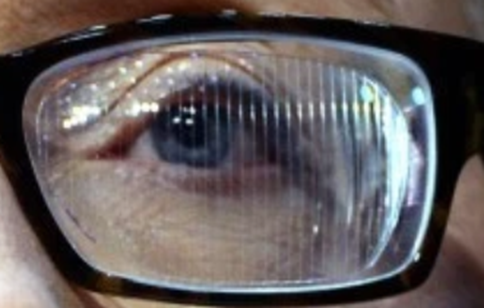Prisms
You or your child has been given prism glasses to help improve double vision (known as diplopia) which may happen when the eyes don’t look in the same direction at the same time. Prisms help by moving the image to make it easier for the eyes to work as a team.
WHAT TYPES OF DOUBLE VISION DO PRISMS HELP WITH?
Prisms can help if the two images are side-by-side, one on top of the other, or even at an angle from each other.
WHAT IF THE IMAGES ARE TILTED?
Prisms can move an image up, down, left, or right. But prisms cannot rotate the image to fix a tilt. Still, they might help the brain bring the images close enough to line them up better.
HOW STRONG DO THE PRISMS NEED TO BE?
Usually, the doctor will give you the lowest strength prism that helps with the double vision. Using a low strength helps the eyes work to fix the problem. If the prism is too strong, it can feel uncomfortable and might even make the eye problem worse.
DO PRISMS CURE STRABISMUS?
No. Prisms don’t make eye muscles stronger or move the eyes into place. They work more like a tool that helps the eyes line up better.
WHAT TYPES OF PRISMS ARE AVAILABLE?
There are two main kinds:
Fresnel (Press-on) Prisms: These are thin and are like a sticker that can be stuck onto your glasses.
Ground-in Prisms: These are built into the glasses by a special shop.
What is the difference between prism types?

Fresnel prisms are easy to change, but they may blur vision and can be seen by others. They also need to be cleaned often. They are usually used for a short time.
Ground-in prisms look like regular glasses and give a clearer image. But they are heavier, thicker on one side, and cost more.
How do I clean glasses that have a Fresnel prism?
You can find helpful instructions online, like at: http://bit.ly/FresnelPrisms

Do prisms have side-effects?
Prisms can make colored edges (like a rainbow) appear around things. Also, the image might not look as sharp as it would without a prism.
How strong can a prism be?
The stronger the prism, the thicker and blurrier it gets. Most people notice some blur with Fresnel prisms stronger than 15 prism diopters (PD). Ground-in prisms can go up to or more than 8 PD per lens, but the glasses will get heavier, thicker, and more expensive.
When do children need prisms?
Children might need prisms after eye surgery or if they tilt their head due to an eye problem. Sometimes prisms are used for other issues like nystagmus (eye shaking), problems with seeing part of their vision, or head position problems. Prisms for kids can be temporary or long-term.
Will I still need surgery if I use prisms?
Maybe. If the eye misalignment is small, prisms may be enough, especially if the person already wears glasses. If the misalignment is big or changes depending on where the person is looking, prisms may only help for a while. Surgery might still be needed later, even if you wear prisms.
Summary for Patients and Caregivers
Prism glasses are a tool to help fix how the eyes work together, especially when there is double vision from a condition like strabismus. Prisms don’t cure the problem, but they can make seeing easier and more comfortable. There are two main types: Fresnel (stick-on) and ground-in (built-in). Each type has pros and cons. Prisms can be helpful for both kids and adults, but some cases may still need surgery. Always talk to your eye doctor if you have questions or concerns about vision.
updated 11/2025